Historic explorers ventured to the rugged West Coast of New Zealand in search of its hidden treasures – gold, pounamu, coal and the opportunity of generational wealth. Nature enthusiasts now travel in the hope of viewing some of New Zealand’s endemic plants and animals, such as the extremely rare Rowi Kiwi. One thing’s for sure; we are all awestruck by the magnificent and jaw-dropping landscapes of this area.
Thanks to the gold rush of the 1860s, towns sprang up in abundance as everyone raced to the West Coast to seek their wealth. Following a short flourish, most people left the area, and the surviving remnants of days past are now shrouded by forest. For those willing to explore, the West Coast still offers a host of treasures and is an excellent choice of location for a South Island road trip.
Top Pick
After travelling through the wonders of the West Coast, the top pick would be the Mirror Lakes of Fox Glacier. Standing on the jetty while the sun sets, the mountain peaks transcend from orange to pink and blue as you marvel at their reflection in the glassy water. Lake Matheson is one of the true beauties of New Zealand that you must experience at least once in your lifetime.
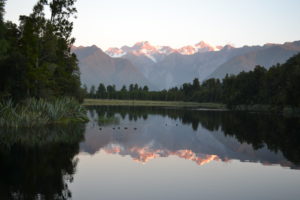
Christchurch
Catching an internal New Zealand flight is as easy as jumping on a train with prior check-in and easy baggage drop. If you’re used to the lengthy process to board an international flight, you’ll be surprised by the ease of plane travel in this country.
The Garden City of New Zealand is the gateway to travel on the South Island. Centred in a region of beaches, boulevards, and vineyards, Christchurch offers plenty to do whether you’re staying for a day or a week.
Canterbury Museum is a great place to start your city tour. You can also learn about our country with a replica 19th-century street and an impressive display of taxidermy that showcases the diverse range of New Zealand birds. The museum is set in the lush surroundings of the botanic garden, complete with native plants, exotic flowers, and impressive sculptures.
If you’re looking for a cocktail bar, the Dirty Land offers a premium range of unique cocktails in a broody and sophisticated “den of cool.” And if you’re after a bite to eat, the adjoining Mexicano restaurant has an abundance of tapas available for delivery direct to your table.
Arthur’s Pass
Arthur’s Pass offers the easiest route through the mountains from Christchurch to the West Coast. Though it can be traversed by car in as little as three hours, this is a destination that you’ll want to assign a whole day to so that you can fully appreciate the surrounding landscapes.
An hour into your journey, you’ll arrive at the Castle Hill conservation area. Here the land is scattered with huge boulders reminiscent of an ancient civilization. Admiring the formations, you would swear that these rocks had been placed by human design, but they are a completely natural occurrence. As you walk toward the boulders, you’ll be in awe of the sheer size and vastness of the complex, and when you turn around, you’ll catch sight of the spectacular mountainous backdrop.
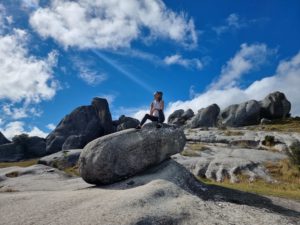
Another hour in the car and you’ll arrive at the Arthur’s Pass village. Here, you’ll find a range of walks, including the Devil’s Punchbowl. During this 90-minute trek, you’ll glimpse some feathered friends, such as the New Zealand robin, who are happy to pose for photographs. This walk will challenge your fitness with a 220 step climb, though the views are well worth the effort. Avalanche Creek offers a range of facilities, an information centre and a chance to view the world’s only alpine parrot, the Kea.
West Coast
The drive to the Paparoa National park is roughly 40 minutes, but you’ll want to stop off a couple of times at the scenic spots along the way.
The pancake rocks are an impressive layered formation whose ingredients were combined more than 35 million years ago. With a bit of imagination, these sculptures turn into faces and wild animals, while the billowing bull kelp below becomes strands of mermaid’s hair bobbing on the water’s surface. And mythical beings aren’t the only creatures you’ll spot at this remarkable destination. Between October and January, you can spot white-fronted terns tending to their nests, and New Zealand Fur Seals are often seen frolicking in the waves or basking on the rocks of this reserve. Plus, you’ll see New Zealand’s largest starfish, the Reef star clinging to the rocks at low tide.
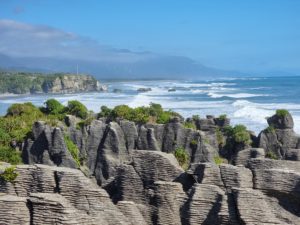
Punakaiki is most frequented for these unique rock formations, but there is much more to explore in the area. The Truman Track offers one of the most interesting short walks on the West Coast, weaving through coastal rainforests to cliff backed beaches. While the Pororari Gorge is one of the best river views in the area, offering magnificent gorge scenery plus the chance to spot some of New Zealand’s less common forest birds.
Hokitika
Continuing your South Island road trip, drive back down the West Coast for an hour, absorbing some of the best coastal views in the world (rated in the top ten by Lonely Planet) until you reach Hokitika.
This “Cool Little Town” has much to offer, including great cafes, mountain views, a wild beach, and the perfect sunset to round off your day. The beach is a short stroll from the main town, where you will find yourself surrounded by a plethora of driftwood, none more famous than the Hokitika sign crafted from these washed-up treasures. In January, join the locals for the driftwood and sand festival that allows budding artists the chance to create unique sculptures from any materials found strewn along the beach.
Along with a rich culture and history, Hokitika offers some stunning natural landscapes and formations. If you only have time for one attraction, make it the Hokitika Gorge. When you see photographs of the vibrant turquoise waters of this area, you’ll swear the images are photoshopped – it’s not until you’re standing on the swing bridge admiring the glacial blue waters for yourself that you can truly appreciate this natural phenomenon.
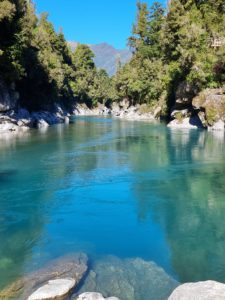
Okarito
Continuing south, you’ll enter glacier country in little more than an hour’s drive. At 3,240 hectares, the Okarito lagoon is the largest unmodified coastal wetland in New Zealand, with shallow estuary waters containing several species, including fish, cockles, snails, and crabs. In addition, about 100 species of birds use the lagoon for food and shelter.
If you want to immerse yourself in this wet wonderland, the area offers several recreational experiences. Join expert guide Barry, at the locally run Okarito Kayaks, for a briefing on the best routes to take. Here, you can get close to the area’s inhabitants, including the white heron in its only NZ location. You’ll also see royal spoonbills, shags, and an array of birdlife that you can identify with a handy guide provided by your host. As you kayak, a sense of serenity overtakes you, and the only sounds you’ll hear are the local wildlife, plus the gentle background noise of distant waves on the beach.
If kayaking isn’t your thing, you can still experience this floating sanctuary aboard a casual yet informative Okarito Boat Eco Tour. The 9 am cruise is the most popular option for making the most of the local birdlife. You’ll board the boat alongside guides Paula and Swade, who will introduce you to the local wildlife plus trout, eels, and an array of native plants.
It may only be 25 minutes from Franz by car, but when you step into Okarito, you’ll feel like you’re a million miles from civilization for the chance to become at one with nature.
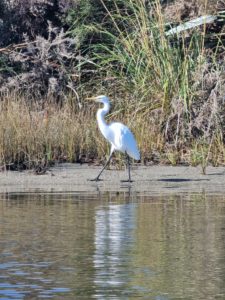
Franz Josef and Fox Glacier
While many travellers make a short stop at this destination for a hike or a heli tour, the area has a lot more to offer and is well worth a four to five day stop to make the most of one of the best places to visit in the South Island.
The glaciers themselves are incredible to look at, and the area offers multiple ways for you to do this. Franz Josef provides a range of walks to various viewing spots, starting at the Franz Josef car park. The glacier walk is a two-hour trek on an easy path that follows the riverbed to an impressive viewpoint. If you’re looking for a shorter hike, try Sentinel Rock, a short steep 20-minute return that offers an elevated view and information about the glacier.
Fox Glacier’s walking track begins just beyond the town, where an hour and a half walk will take you along the river bed to a scenic viewing platform and back. You can enjoy the impressive ice-grey waters of the glacial soup racing beneath you, and though the viewing platform is some distance from the glacier itself, you’ll still be left in awe at this wonder of nature.
As both glaciers are experiencing rapid retreat, a helicopter tour is the only way to see these unusual ice formations up close. Heli Services offer a single, twin, or “grand tour” (which also encompasses Mounts Cook and Tasman) where you’ll have a front-row seat to experience these ice valleys up close. Heli Services also provide a snow landing not far from the neve, where you can touch the world’s densest ice and snap off as many selfies as you’d like.
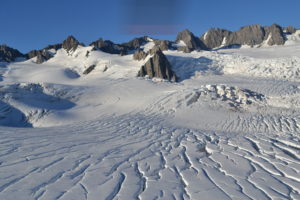
Back on terra firma, allow plenty of time to explore the other treasures of this area. The West Coast Wildlife centre is a must; whether you’re looking for an up-close encounter with the rare Rowi kiwi or want to learn more about the glacier formation of the area, this centre has it all. A backstage VIP pass is worth the additional dollars to gain the insight of knowledgeable guides such as Kath, who will take you behind the scenes of Operation Nest Egg to see how the Rowi chicks are nurtured and protected, plus provide a face-to-face encounter with the tuatara. Afterwards, you can enter the museum at your leisure and experience a rare sighting of the Rowi, with only a pane of glass separating you from them.
With many great walks on offer, it’s challenging to know which one to choose. The Callery Gorge offers pristine views of the icy grey waters cascading through the river valley. Another option is the Terrace walk, a short forested area that transports you away from the bustle of the town and provides a primo glowworm viewing area in the evening.
After all that walking, it’s nice to unwind and relax, and there’s nowhere better to do this than Waiho hot tubs. These wood-fired pools provide a private spot for a calming soak. Your only visitors will be a couple of feathered friends, including the spirited fantail drawn to your luscious green surroundings. With fresh mountain water and temperature control, you’ll feel like you’ve entered a secret location in the middle of the forest.
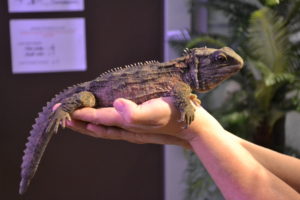
In Fox Glacier, enjoy breakfast at the Lake Matheson Cafe, where you can admire the local views, learn about the area via its information boards, and browse for a unique gift at the onsite shop. Here, you’ll find two walks: the Lake Matheson track and the Lake Gault track. The Mirror lakes are best visited during dawn or dusk to experience the full effect of the reflective peat waters.
While you’re in the area, make sure you take the trip to Gillespies beach. You can enjoy spectacular ocean views as you listen to the thrashing waves churning up the rocky shore – you can also take a bush walk alongside the dunes, where you’ll discover mining remnants and a lagoon. You can even view fur seals at the right time of the year.
Queenstown/Wanaka
To complete your South Island road trip, continue heading down the West Coast, along the scenic Haast Pass to Queenstown. To break up this four-hour drive, stop in Wanaka, where you can enjoy everything from scenic cruises to skydiving. Try a unique “iron road” climbing experience that uses ladders, iron rungs, and cables to access some of the area’s most scenic spots; scale rock faces, traverse rope bridges, and seek out hidden waterfalls on this intimate tour experience.
If you’re looking for an adventure that’s less adrenaline-inducing, try Puzzling World, filled with wonderful weirdness such as the “sculptillusion” gallery and roman toilets. Snap off a selfie at the leaning tower before heading to the Think Tank cafe for a bite to eat.
Wanaka is the perfect prelude to the adventure capital of the world, Queenstown. With an average of three million visitors a year pre COVID, this city boasts an array of thrilling experiences, from New Zealand’s highest Bungy jump to ziplining and skydiving.
Queenstown is one of the best places to visit in the South Island and the perfect spot to end your road trip. This city offers an abundance of activities and a gateway to many other parts of beautiful New Zealand.
All-in-all, the South Island of New Zealand is an adventure playground an everything that Mother Nature intended in all it’s glory. Enjoy, discover, and thank you for reading.